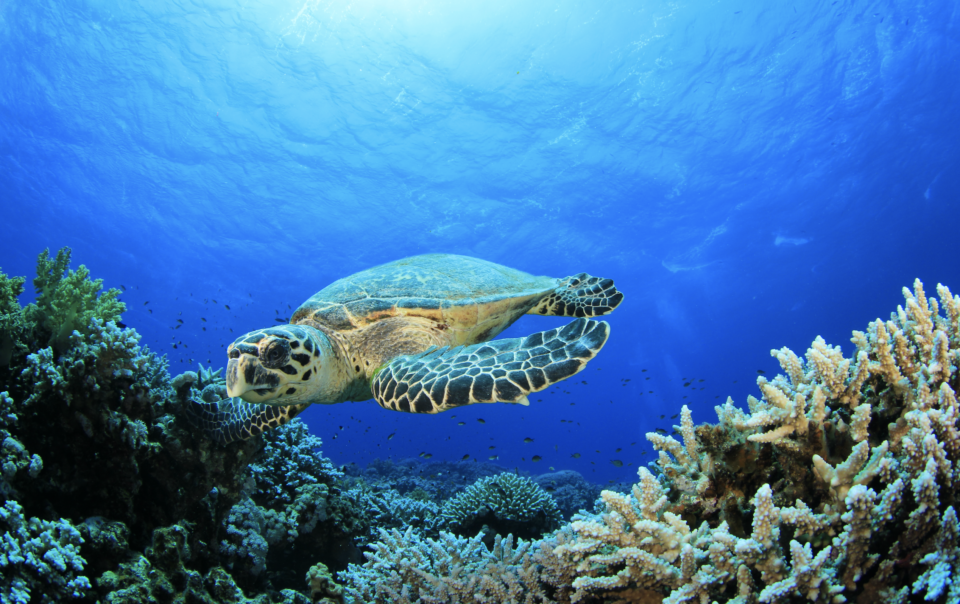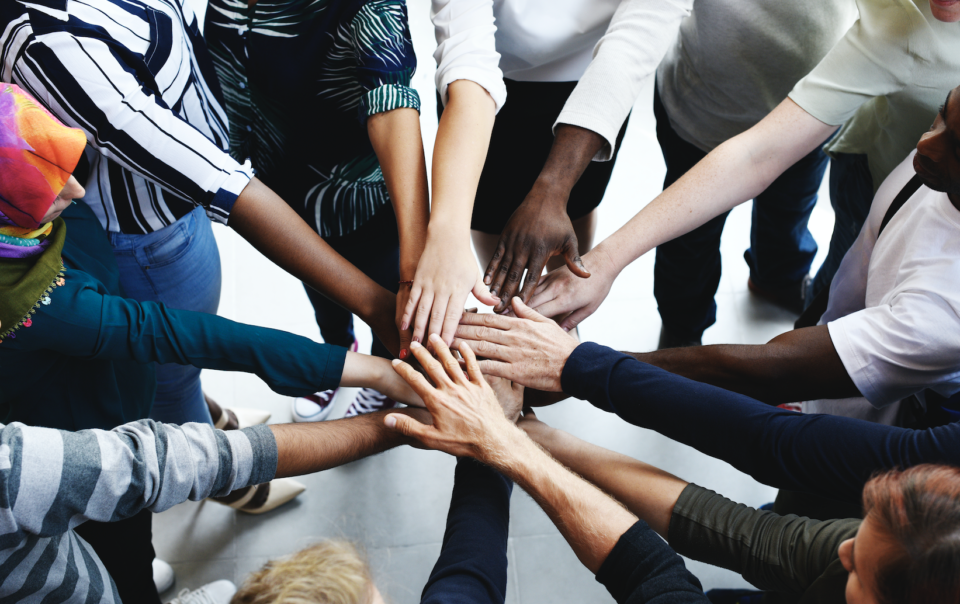
Green Logistics เป็นกระบวนการบริหารจัดการโลจิสติกส์ ที่มุ่งเน้นในการลดผลกระทบต่อสิ่งแวดล้อม ที่เกิดจากกิจกรรมต่างๆ ที่เกี่ยวข้องกับโลจิสติกส์ อาทิเช่น การเคลื่อนย้าย รวบรวม จัดเก็บ กระจายสินค้า ซึ่งในวันนี้ประเด็นนี้กำลังเป็นเรื่องสำคัญที่หลายๆ องค์กรกำลังขับเคลื่อนกันอย่างจริงจัง
ร้านเซเว่น อีเลฟเว่น (7-Eleven) เป็นร้านสะดวกซื้อที่พวกเราคุ้นเคย และอยู่คู่กับคนไทยมาอย่างยาวนาน ช่วยให้เราสามารถไปเลือกซื้อของกินแสนอร่อยและของใช้ครบครันได้ตลอด 24 ชั่วโมง แต่รู้ไหมว่าเบื้องหลังร้านสะดวกซื้อแห่งนี้ ไม่ได้มุ่งมั่นแค่การให้บริการเท่านั้น พวกเขายังปฏิบัติการด้านสิ่งแวดล้อมอย่างจริงจังมายาวนาน ผ่านนโยบาย 7 Go Green ตั้งแต่ปี 2550
ระบบขนส่งคือหัวใจสำคัญของร้านสะดวกซื้อ เพื่อจัดเตรียมสินค้าให้พร้อมสำหรับลูกค้าอยู่เสมอ อย่างไรก็ตามระบบทั้งหมดที่ว่าต้องใช้พลังงานในการขับเคลื่อน ซึ่งทีมงานเซเว่น อีเลฟเว่น ตระหนักและให้ความสำคัญกับเรื่องนี้เป็นอย่างมาก
ตลอดหลายปีที่ผ่านมาพวกเขาจึงทั้งปรับเปลี่ยน พัฒนา และสร้างนวัตกรรมใหม่ๆ ขึ้นมากมาย เพื่อให้ระบบขนส่งและกระจายสินค้าปล่อยก๊าซเรือนกระจกน้อยลง ในขณะที่ยังคงประสิทธิภาพเต็มเปี่ยม ซึ่งก็นับเป็นภารกิจที่ท้าทายอย่างมาก เพราะเซเว่น อีเลฟเว่น มีสาขาครอบคลุมทั่วประเทศ
The Practical ชวนคุณตามรอยเส้นทางระบบขนส่งสีเขียวหรือ Green Logistics ที่ทำให้ทุกวันนี้สินค้าบนชั้นวางในร้านเซเว่น อีเลฟเว่น ทุกชิ้นถูกจัดส่งด้วยระบบที่ปล่อยก๊าซเรือนกระจกน้อยลง โดย คุณคำภีร์ เมตตา ผู้ช่วยกรรมการผู้จัดการ สำนักปฏิบัติการศูนย์กระจายสินค้าต่างจังหวัด บริษัท ซีพี ออลล์ จำกัด (มหาชน) จะมาเป็นผู้บอกเล่าความเป็นมิตรกับสิ่งแวดล้อม ซึ่งเริ่มตั้งแต่ต้นทางที่ศูนย์กระจายสินค้าสู่ปลายทางในร้านเซเว่น อีเลฟเว่นใกล้บ้านทุกคน
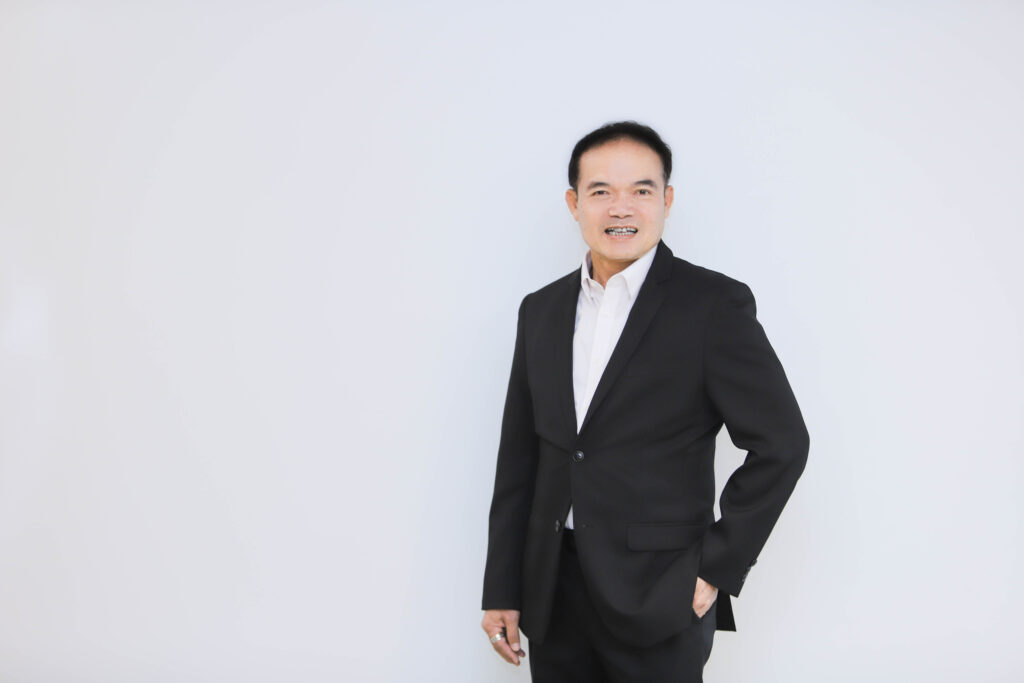
ความยั่งยืนที่อยู่เบื้องหลัง
มื่อพูดถึงความเป็นมิตรต่อสิ่งแวดล้อมของร้านเซเว่น อีเลฟเว่น เชื่อว่าผู้บริโภคส่วนใหญ่น่าจะนึกถึงแคมเปญ และการรณรงค์ที่เห็นได้อย่างชัดเจนอย่างการลดใช้ถุงพลาสติกครั้งเดียวทิ้ง หรือการเปลี่ยนมาใช้บรรจุภัณฑ์รักษ์โลกอย่างไรก็ตามยังมีการดำเนินงานอีกส่วนหนึ่ง ซึ่งแม้จะเป็นงานเบื้องหลังแต่ก็ส่งผลเชิงบวกต่อสิ่งแวดล้อมไม่แพ้กันนั่นคือ ‘ระบบขนส่งสีเขียว’
“เรามีร้านสาขาอยู่มากกว่าหมื่นแห่ง โดยทั้งหมดรับสินค้ามาจากศูนย์กระจายสินค้าที่ กระจายอยู่ตามภูมิภาคทั่วประเทศ ดังนั้นความท้าทายแรกคือจะขนส่งและกระจายสินค้ายังไงให้ยังมีประสิทธิภาพ แต่ในขณะเดียวกันก็ทำให้ก๊าซเรือนกระจกที่เกิดจากการวิ่งรถน้อยลง”
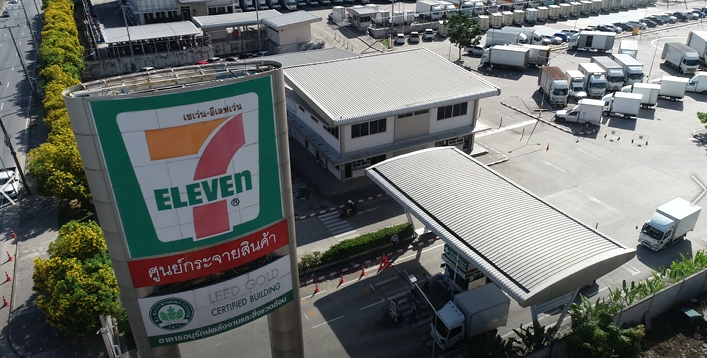
“ความท้าทายต่อมาคือการบริหารจัดการศูนย์กระจายสินค้าขนาดใหญ่ ในการจัดเก็บสินค้าประเภทต่างๆ เราต้องอาศัยพลังงานมหาศาล ดังนั้นพลังงานที่เลือกใช้จึงต้องเป็นประเภทที่สร้างก๊าซเรือนกระจกน้อยที่สุด”
เพิ่มขนาดรถ เพื่อลดระยะทาง
คุณคำภีร์เล่าว่าในแต่ละวัน เซเว่น อีเลฟเว่น มีรถที่วิ่งส่งสินค้าอยู่ทั่วประเทศประมาณ 3,000 คัน โดยวิ่งจากศูนย์กระจายสินค้าแต่ละแห่งไปยังร้านสาขาในพื้นที่วันละเกือบ 8,000 เที่ยว ดังนั้นจึงไม่น่าแปลกใจที่เรามักเห็นรถขนส่งสินค้าบนท้องถนนอยู่บ่อยๆ
“การขนส่งสินค้าต้องอาศัยความคล่องตัว เพราะร้านบางสาขาอยู่ในซอยเล็กๆ บางร้านอยู่บนถนนใหญ่ก็จริงแต่มีที่ให้จอดรถขนถ่ายสินค้านิดเดียว ถ้าเลือกใช้รถปิกอัพสี่ล้อทั่วไปก็จะมีข้อจำกัดเรื่องปริมาณที่สามารถบรรทุกได้ สุดท้ายจึงได้คำตอบเป็นนวัตกรรมรถสี่ล้อจัมโบ้ ซึ่งสามารถสินค้าได้มากกว่าเดิมถึงสามสิบเปอร์เซ็นต์ “
คุณคำภีร์บอกว่า เมื่อเซเว่น อีเลฟเว่น ใช้รถที่ขนาดเหมาะสมกับการใช้งาน จำนวนรถที่ต้องใช้และจำนวนเที่ยวที่ต้องวิ่งต่อวันก็น้อยลง ซึ่งแน่นอนว่าส่งผลให้การปล่อยก๊าซเรือนกระจกจากขั้นตอนตรงนี้ลดน้อยลงไปด้วย
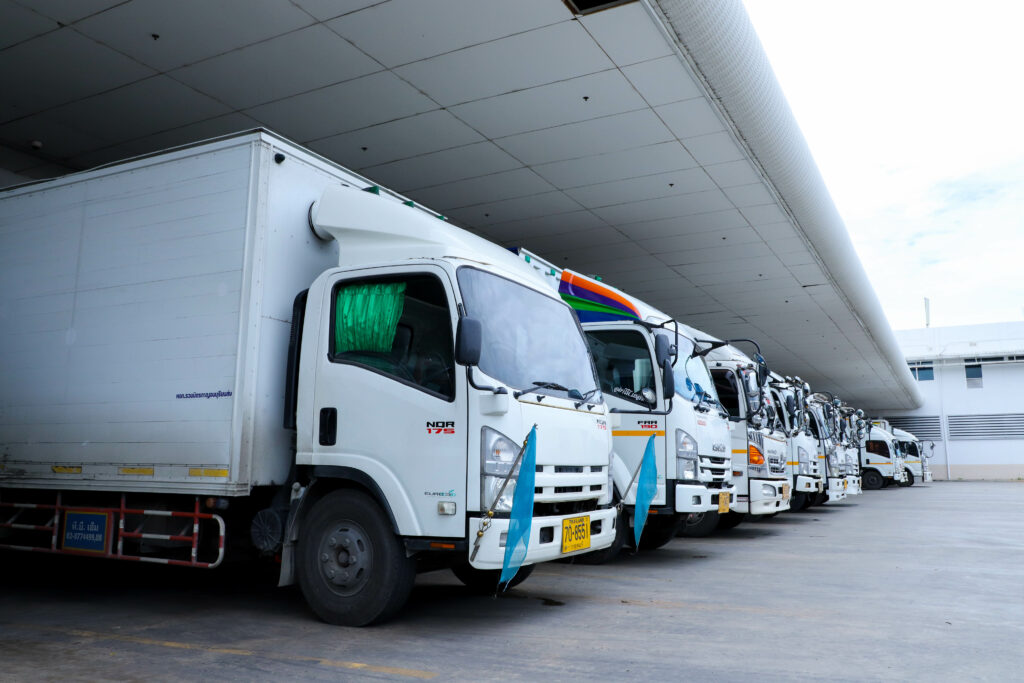
“เรายังพัฒนาระบบปฏิบัติการที่เรียกว่า Territory Planner ขึ้นมาด้วย เพื่อใช้กำหนดเส้นทางเดินรถที่ดีที่สุด ทำให้เราวิ่งสั้นลง ในเวลาที่น้อยลง เดิมอาจต้องใช้ระยะทางร้อยกิโลเมตร แต่ด้วย Territory Planner เส้นทางใหม่ที่คำนวณจะมีระยะทางสั้นลงห้าถึงยี่สิบเปอร์เซ็นต์ ช่วยลดจำนวนรถบนท้องถนน ส่งผลให้ลดการปล่อยก๊าซคาร์บอนไดออกไซด์และมลภาวะสู่สิ่งแวดล้อม”
อาคารเขียวที่ทำให้โลกเขียว
ศูนย์กระจายสินค้าแต่ละแห่งของเซเว่น อีเลฟเว่น จำเป็นต้องมีขนาดใหญ่ เพราะอย่างที่กล่าวไปข้างต้นว่าร้านสาขานั้นมีมากกว่าหมื่นแห่ง ยังไม่นับว่าสินค้าที่นำเสนอให้ผู้บริโภคนั้นมีมากมายหลากหลายเพื่อตอบสนองการใช้ชีวิตของคนไทย
“ในการสร้างศูนย์กระจายสินค้า เราจึงให้ความสำคัญกับตัวอาคารอย่างมาก เพื่อให้ระบบที่อยู่ภายในสนับสนุนการจัดเก็บและกระจายสินค้าอย่างมีประสิทธิภาพ แต่ขณะเดียวกันก็ใช้พลังงานและปล่อยก๊าซเรือนกระจกน้อยลง สิ่งเหล่านี้ต้องวางแผนกันตั้งแต่แรกร่วมกับผู้ออกแบบ ผู้รับเหมาก่อสร้าง และทีมงานอีกหลายๆ ส่วน”
ศูนย์กระจายสินค้าของเซเว่น อีเลฟเว่น ก่อสร้างขึ้นภายใต้มาตรฐานอาคารเขียวหรือ Green Building ที่คำนึงถึงการประหยัดพลังงาน การรักษาและพัฒนาพื้นที่รอบข้าง การประหยัดน้ำ การเลือกใช้วัสดุที่เป็นมิตรต่อสิ่งแวดล้อม และคำนึงถึงสภาพอยู่สบายของผู้ใช้อาคาร
“ตัวอาคารของศูนย์กระจายสินค้าเป็นอาคารเขียวอยู่แล้วก็จริง แต่หลังจากทีมงานของเราได้พูดคุยหารือ เราก็เห็นตรงกันว่ามันน่าจะต่อยอดความเป็นมิตรต่อสิ่งแวดล้อมไปได้ไกลกว่านี้อีก ด้วยขนาดที่ใหญ่โตทำให้ศูนย์กระจายสินค้าแต่ละแห่งมีพื้นที่หลังคาเยอะมาก รวมกันทั่วประเทศคือประมาณสองแสนตารางเมตร ทีมของเราจึงใช้ความกว้างขวางตรงนี้ให้เป็นประโยชน์ด้วยการติดตั้งแผงโซลาร์เซลล์ผลิตกระแสไฟฟ้า”
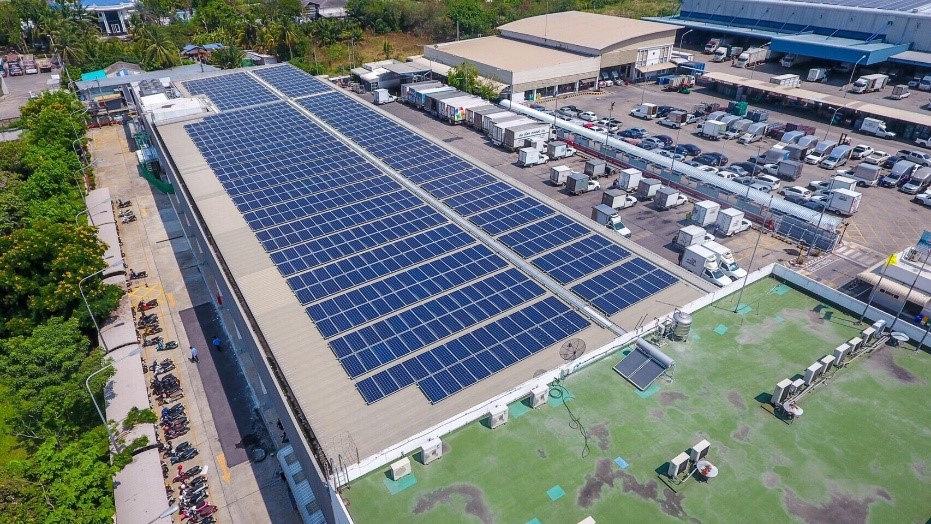
พลังงานแสงอาทิตย์คือหนึ่งในพลังงานหมุนเวียนที่เป็นพลังงานสะอาด หมุนเวียนกลับมาใช้ใหม่ได้เรื่อยๆ และปล่อยก๊าซเรือนกระจกต่ำกว่า ทุกวันนี้ศูนย์กระจายสินค้าทุกแห่งของเซเว่น อีเลฟเว่นใช้ไฟฟ้าจากโซลาร์เซลล์บนหลังคาตัวเมือง 80ถึง 90 เปอร์เซ็นต์ของการใช้พลังงานทั้งหมด
คุณคำภีร์อธิบายอย่างกระตือรือร้นว่า “อีกหนึ่งองค์ประกอบเล็กๆ ที่ผมมองว่าเป็น Game Changer เลยก็คือหลอดไฟแบบสมาร์ท LED ที่จับการเคลื่อนไหวของคน โดยมันจะเปิดและปิดเองอัตโนมัติ ซึ่งชิ้นส่วนเล็กๆ นี้ช่วยประหยัดพลังงานไปเยอะมากเช่นกัน”
ร้านสะดวกซื้อของโลกและผู้คน
ในฐานะทีมงานผู้อยู่เบื้องหลังการขับเคลื่อนระบบขนส่งสินค้าสีเขียว ที่ทำให้ผู้บริโภคทุกคนมีส่วนช่วยลดการปล่อยก๊าซเรือนกระจก คุณคำภีร์บอกว่าพวกเขารู้สึกภูมิใจและดีใจมาก เพราะสินค้าอุปโภคบริโภคคือสิ่งที่คนต้องกินต้องใช้กันอยู่ทุกวัน เมื่อร้านค้าปลีกและร้านสะดวกซื้อส่งมอบสินค้าด้วยกระบวนการที่ปล่อยก๊าซเรือนกระจกน้อยลง ก็เท่ากับเป็นจิ๊กซอว์ให้ผู้บริโภคที่ซื้อสินค้าได้ร่วมสร้างการเปลี่ยนแปลงสู่ความยั่งยืนไปด้วย
โดยปีที่ผ่านมา ทีมงานเซเว่น อีเลฟเว่น ช่วยลดปริมาณการปล่อยก๊าซเรือนกระจกออกสู่ชั้นบรรยากาศไปได้กว่า 6,600 ตันคาร์บอนไดออกไซด์
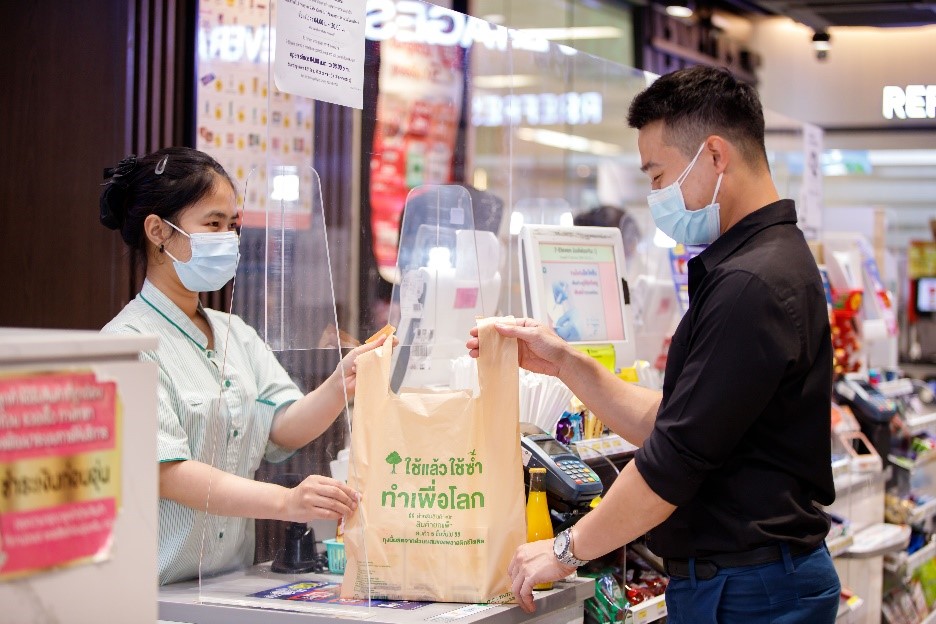
“เทียบให้เห็นภาพชัดเจนขึ้น คือเท่ากับการปลูกต้นไม้หนึ่งแสนห้าหมื่นต้นต่อปี แต่เราจะไม่หยุดพัฒนานวัตกรรมใหม่ๆ สำหรับเป้าหมายของปีนี้ เราต้องการลดการปล่อยก๊าซลงให้ได้มากกว่าเจ็ดพันตันคาร์บอนไดออกไซด์ และทีมของเราตั้งใจที่จะไปสู่เป้าหมายด้านความยั่งยืนที่ใหญ่ขึ้นเรื่อยๆ ในแต่ละปี เพื่อผู้บริโภคและเพื่อโลกของเรา”
เราปรับ โลกเปลี่ยน The Next Generation: Green Logistics ขนส่งลดคาร์บอน
หรือ จะเลือกรับฟังรายการ ในรูปแบบของ Podcast ได้ที่:
เราปรับ โลกเปลี่ยน The Next Generation เพราะเราทุกคน ”เปลี่ยน” โลกให้ดีขึ้นได้ พบหลาก idea หลาย action ของคนรุ่นใหม่ที่ลุกขึ้นมา “ปรับ” คิดแล้วลงมือทำ เพื่อร่วมกันสร้างโลกให้ยั่งยืน
WeShiftWorldChange #NextGeneration #เราปรับโลกเปลี่ยน #ทุกคนเปลี่ยนโลกให้ดีขึ้นได้

